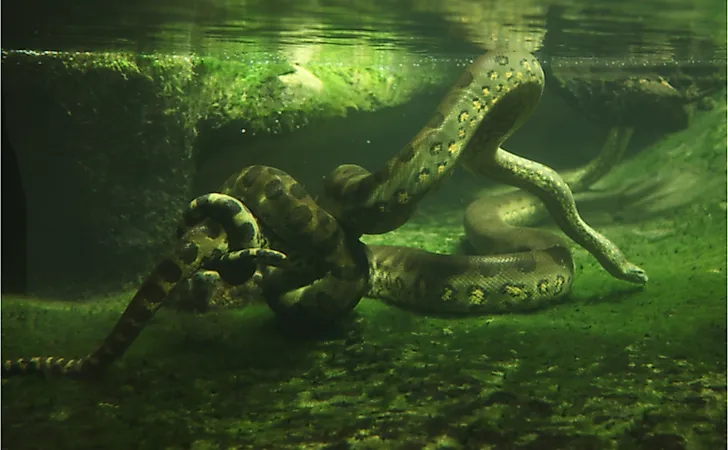

An anaconda’s jaw is super flexible as it is attached to stretchy ligaments. Instead, they wrap their massive muscular bodies around their prey and squeeze until their victim stops breathing. Not quite… Since anacondas are part of the family of constrictors, they are not venomous and hence won’t kill their prey through bites. The green anaconda’s sexual dimorphism (the difference in apparel between two sexes of the same species) is the biggest size difference known amongst vertebrates in the entire world! To be specific, the average female anaconda is around 4.5 m (15 feet) long, whereas the average size of a male is around 2.7 m (9 feet). But the females are even bigger than the males! Not only are they a fair bit longer, but also stronger than their male conspecifics. Who runs the world? Girls!Īs just mentioned, anacondas are pretty very big snakes in general. While the reticulated python beats the anaconda to first place in the run for ‘world’s longest snake’, the anaconda is definitely the heaviest one with up to 230kg (550 pounds)! That’s definitely not the type of snake you would like to wrap around your neck for a dare… 4.

#Pet full grown green anaconda skin
Humans are the snake’s predator number one: They kill the boa species just out of dislike, and poachers commonly hunt them illegally for their skin which they then sell for big bucks as part of unauthorized pet trade. In fact, humans jeopardize them just as much as the other way around, if not more. However, there has not been a single verified report yet of an anaconda eating a human for breakfast! While they would definitely be capable to do so (considering anacondas also feed on crocodiles, deer, and even jaguars, swallowing them as a whole), humans are not part of anacondas’ meal plan. Most humans are pretty scared of snakes in general and anacondas specifically, probably due to their enormous strength and size. Sounds almost as simple as Uber Eats, right? 2. That way, they can easily sit and wait for prey while staying hidden underwater. They mostly hunt prey from within the waters, since anacondas have their eyes and nasal openings on top of their head. In fact, the anaconda can also hold its breath for up to 10 minutes while being below the water surface, which proves them to be pretty good divers. That says it all, doesn’t it? While the snake can get its speed up to 8 km/h on land, it is twice as fast (16 km/h) under water. The anaconda’s scientific name is ‘Eunectes murinus’, which is derived from the Greek meaning ‘good swimmer’. But there’s so much more to know about the ‘Queen of the Rain Forest’, so check out our five fun (and mildly intimidating) facts about anacondas below! Green anaconda. That’s more than two fully grown men together! The semiaquatic snake lives in the tropical regions of the Amazon as it likes to be in or at least near water. The ‘Green Anaconda’ can get up to nine (!) meters long and weighs up to 230kg (550 pounds). Thank you.While Australia is generally known to be home to the biggest and scariest animals on earth, the world’s largest snake actually lives in South America. From as little as £2, you can help us create a future where both people and the planet thrive. No matter the size, every gift to the Museum is critical to our 300 scientists' work in understanding and protecting the natural world. We are a charity and we rely on your support. Understanding and protecting life on our planet is the greatest scientific challenge of our age. To reverse the damage we've done and protect the future, we need the knowledge that comes from scientific discovery.

People tell us they 'still get shivers walking through the front door', and thank us for inspiring the next generation of scientists. We must act on scientific evidence, we must act together, and we must act now.įor many, the Natural History Museum is a place that inspires learning, gives purpose and provides hope. But if we don't look after nature, nature can't look after us. This is the first time in Earth's history that a single species - humanity - has brought such disaster upon the natural world. Climate change is creating deserts and dead zones, and hunting is driving many species to the brink of extinction. Pollution has caused toxic air in our cities, and farming and logging have wreaked havoc on our forests. Our future depends on nature, but we are not doing enough to protect our life support system. Now we're wondering if you can help us.Įvery year, more people are reading our articles to learn about the challenges facing the natural world. or that it helped you learn something new.


 0 kommentar(er)
0 kommentar(er)
